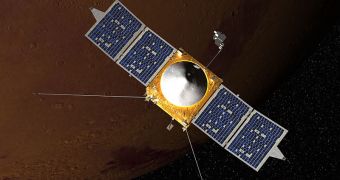Unlike missions that came before it, the NASA Mars Atmosphere and Volatile EvolutioN (MAVEN) spacecraft will not be conducting studies of the Red Planet's surface, but rather of its atmosphere. Scientists hope that this will allow us to understand how Mars lost its ability to support the development of life, provided that such ability ever existed.
MAVEN is scheduled to launch later today, November 18, from Launch Complex 41 (LC-41) at the Cape Canaveral Air Force Station (CCAFS), in Florida. The first attempt at takeoff will occur at 1:28 pm EST (1828 GMT), but the launch window will remain open until 3:28 pm EST (2028 GMT).
NASA TV will be providing a live coverage of the event beginning at 11 am EST (1600 GMT). The $671 million (498 million euro) orbiter will be launched to space aboard an Atlas V rocket, and is scheduled to achieve orbital insertion around Mars on September 22, 2014.
The main purpose of the MAVEN mission will be to survey the upper reaches of the Martian atmosphere, and particularly the planet's ionosphere. Experts say that this will enable them to recreate our neighboring world's history, and figure out how its now-dead core influenced its development.
When Mars formed, theories suggest, the world was very similar to Earth. It had water running freely on its surface and a rich atmosphere that may have provided the stage for the development of life. However, this did not happen because the planet's core stopped a few billion years ago.
When this happened, the magnetic field that protected Mars from solar radiations was destroyed, and charge particle fluxes from the Sun slowly stripped away the atmosphere. MAVEN will investigate how this process occurs today, potentially yielding new data for planetary sciences.
The spacecraft will also be scanning the lower reaches of the atmosphere, in a bid to discover the source of the relatively large volumes of methane that have been detected there. According to scientists, there is too much methane on Mars to be accounted by normal geological processes.
Some researchers suggest that bacteria colonies may be producing this compound, but there is no way to be certain if that is true at this point. The sensitive instruments on MAVEN will help NASA researchers pinpoint the source of Martian methane with a high degree of precision, Space reports.
“The Martian atmosphere is a critical piece of the puzzle of how Mars works. Certainly Mars was born with a different atmosphere than we think we see today,” says NASA Goddard Space Flight Center (GSFC) chief scientist, Jim Garvin.

 14 DAY TRIAL //
14 DAY TRIAL //